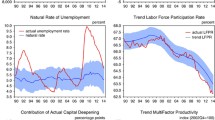Abstract
The slope of the aggregate supply curve of the economy in economic schools is influenced by the assumptions of the labor market. In classical economics, assuming no monetary illusion of labor, the aggregate supply curve is a vertical line at full employment. In the great crisis of the 1930s, Keynes introduced the horizontal aggregate supply to the economic world as a special state of the economy, and Keynesian economics presented the aggregate supply with a positive slope assuming the existence of monetary illusion. The monetarists with the hypothesis of adaptive expectations considers the aggregate supply in the short term with a positive slope like the Keynesians and vertical in the long term like the classics. The new classics with the assumption of rational expectations, although they consider the aggregate supply with a positive slope, but they provide the same results as the classics. Nevertheless, aggregate supply in inflationary crises as a special state of the economy has not been discussed in economic schools so far, and there is a study gap in this regard. The current research seeks to present a new theory regarding the aggregate supply of the economy in inflationary crises. The purpose of this research is to provide a new theory about the supply of the entire economy in inflationary crises, which is a basis for future research, especially for countries that are facing inflationary crises.



Similar content being viewed by others
Notes
In this case, the profit of the representative firm (π) becomes as follows.
$$\uppi ={\text{Py}}-{\text{WN}}={\text{Pf}}\left({\text{N}}\right)-{\text{WN}}={\text{P}}\left\{{\upbeta }_{1}{\text{N}}-\left(1/2\right){\upbeta }_{2}{{\text{N}}}^{2}\right\}-{\text{WN}}$$Then, the first order condition of the profit maximization of the price-taking firm is.
$$\frac{{\text{dP}}}{{\text{dN}}}={{\text{Pf}}}\left({\text{N}}\right)-{\text{W}}={\text{P}}\left({\upbeta }_{1}-{\upbeta }_{2}{\text{N}}\right)-{\text{W}}=0$$In this case, the second order condition is satisfied because.
$$\frac{{{\text{d}}}^{2}\uppi }{{{\text{dN}}}^{2}}=-{\text{P}}{\upbeta }_{2}<0$$
References
Branson WH (1997) Macroeconomic theories and policies, 10th edn. Ney Publishing, Tehran
Carrera C, Ramírez NR (2014) Inflation, information rigidity, and the sticky information Phillips curve. Macroecon Dyn 23(7):2597–2615
Fakhr Hosseini SF, Eisazadeh Roshan Y (2018) The effect of imperfect information on aggregate supply: a case study of Iran’s economy. Res J Macroecon 28(14):290–261
Goyal A, Kumar A (2021) Asymmetry, terms of trade and the aggregate supply curve in an open economy model. J Econ Asymmetries 24:1–16
Madsen JB (2003) New Keynesian versus new classical theories of aggregate supply: evidence from the OECD countries. Scott J Polit Econ 45(3):273–192. https://doi.org/10.1111/1467-9485.00096
Nofarsti M (1999) Unit root and cointegrationin econometrics. Publications of Rasa Cultural Services Institute, Tehran
Omar HMNB (2012) The dynamics of aggregate demand and supply shocks in ASEAN countries. J Asian Econ 23:507–518
Rahmani T (2007) Macroeconomics 2, 1st edn. Payam Noor University Press, Tehran
Stuart R (2022) 160 years of aggregate supply and demand in Switzerland. Swiss J Econ Stat. https://doi.org/10.1186/s41937-022-00096-2
Tafazoli F (2007) Macroeconomics, economic theories and policies, 17th edn. Nay Publication, Tehran
World Bank. https://data.worldbank.org/
Zuriarrain JB (2022) Credit-fueled demand and shrinking aggregate supply: a study on the hyperinflation in Venezuela. Rev Polit Econ 21:1–21. https://doi.org/10.1080/09538259.2022.2037932
Author information
Authors and Affiliations
Corresponding author
Ethics declarations
Conflict of interest
The authors have no relevant financial or non-financial interests to disclose.
Ethical approval
This article does not contain any studies with human participants performed by any of the authors.
Additional information
Publisher's Note
Springer Nature remains neutral with regard to jurisdictional claims in published maps and institutional affiliations.
About this article
Cite this article
Saadatmehr, M. Downward aggregate supply curve in inflation crisis. Evolut Inst Econ Rev 21, 21–41 (2024). https://doi.org/10.1007/s40844-024-00277-z
Received:
Accepted:
Published:
Issue Date:
DOI: https://doi.org/10.1007/s40844-024-00277-z




